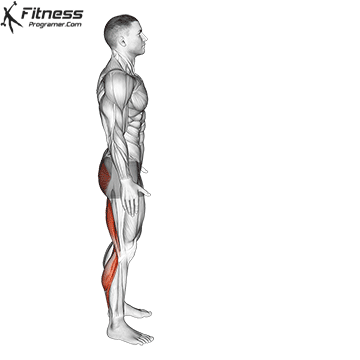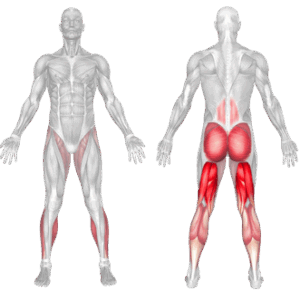Overview
The Standing Hamstring Stretch is a static flexibility exercise designed to lengthen the hamstrings, improve posterior chain mobility, and support lower back health. It involves standing upright and hinging forward at the hips to stretch the back of the thighs with straight knees. This movement is effective for reducing muscle stiffness, enhancing athletic performance, and preventing injury.
It is commonly performed during warm-ups, cool-downs, yoga routines, and rehabilitation protocols for individuals with tight or shortened hamstrings. It is an accessible stretch for all fitness levels and requires no equipment, making it ideal for home, gym, or travel settings.
How to Perform the Standing Hamstring Stretch

Starting Position: Stand tall with your feet together or hip-width apart and arms relaxed by your sides.
Brace and Align: Engage your core slightly and keep a neutral spine as you prepare to hinge forward.
Bend Forward: Take your right leg one step forward. Slowly hinge at the hips and lower your torso toward your legs. Let your arms hang down or reach toward your toes.
Stretch Phase: Keep your knees straight or only slightly bent (if needed). Relax your neck and let your head hang freely.
Hold the Position: Stay in the stretch for 20–30 seconds, breathing deeply and avoiding bouncing.
Return to Start: Slowly roll up vertebra by vertebra until you’re standing upright again. Repeat with your other leg.
Tips for Proper Form
Hinge at the hips, not the lower back, to avoid strain and ensure proper stretch targeting.
Keep knees soft if your flexibility is limited to avoid pulling on tendons.
Exhale as you fold forward to release muscular tension.
Avoid rounding your upper back too much—aim for long spine extension.
Perform on a flat surface for better balance and control.
Common Mistakes
Locking the knees: Can place excessive tension on the joints and reduce stretch effectiveness.
Rounding the back aggressively: Reduces the stretch on the hamstrings and risks spinal strain.
Holding your breath: Restricts relaxation and may elevate tension.
Bouncing or jerking: Increases injury risk and is not appropriate for static stretching.
Pushing too far: Stretching should be intense but never painful.
Benefits of the Standing Hamstring Stretch
Improves hamstring flexibility: Helps restore full length to the muscle, improving movement efficiency.
Reduces lower back tension: Lengthening the posterior chain supports spinal decompression and posture.
Enhances athletic performance: Improved hamstring length supports better stride length, jumping ability, and hip extension.
Prevents injury: Flexible hamstrings reduce the likelihood of strains during physical activity.
Increases range of motion: Promotes better joint mobility in the hips, knees, and spine.
Supports spinal alignment: Encourages awareness of hip-hinge mechanics and core stability.
Accessible anywhere: Requires no equipment and minimal space—ideal for daily mobility practice.
How to Incorporate Into Your Routine
- For General Flexibility: Use this stretch at the end of any lower-body or full-body workout. Hold for 20–30 seconds for 2–3 rounds.
- For Morning Mobility: Perform upon waking to counteract overnight tightness and promote circulation.
- For Athletic Warm-ups: Pair with dynamic versions (like toe touches or leg swings) after warming up the body.
- For Cool-down: Use after strength or endurance training to reduce post-workout tension in the hamstrings and lower back.
- For Desk Workers: Include in daily movement breaks to alleviate tightness caused by prolonged sitting.
- For Injury Prevention: Use alongside glute and core strengthening exercises to prevent compensatory hamstring strain.
Muscles Worked

Frequently Asked Questions
Can beginners perform this stretch safely?
Yes. Beginners should maintain a slight bend in the knees and focus on controlled breathing and spinal alignment.
How often should I stretch my hamstrings?
2–4 times per week is effective for most people. Daily stretching is safe if done gently.
What should I do if I feel pain behind my knees?
Back off slightly and bend your knees. Pain may indicate overstretching or improper alignment.
Should I do this stretch before or after my workout?
Static stretching like this is best done after workouts. For pre-workout, use dynamic hamstring warm-ups.
What’s the difference between this and seated hamstring stretches?
The standing version includes a balance and spinal alignment component, while the seated version offers more stability and support.
